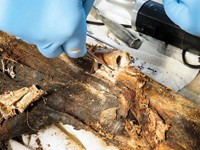Advertisement
Grab your lab coat. Let's get started
Welcome!
Welcome!
Create an account below to get 6 C&EN articles per month, receive newsletters and more - all free.
It seems this is your first time logging in online. Please enter the following information to continue.
As an ACS member you automatically get access to this site. All we need is few more details to create your reading experience.
Not you? Sign in with a different account.
Not you? Sign in with a different account.
ERROR 1
ERROR 1
ERROR 2
ERROR 2
ERROR 2
ERROR 2
ERROR 2
Password and Confirm password must match.
If you have an ACS member number, please enter it here so we can link this account to your membership. (optional)
ERROR 2
ACS values your privacy. By submitting your information, you are gaining access to C&EN and subscribing to our weekly newsletter. We use the information you provide to make your reading experience better, and we will never sell your data to third party members.
Forensic Science
Mining proteins for crime scene clues
Proteomics can answer questions that DNA analysis can’t, offering complementary information for forensic investigations
by Carolyn Wilke, special to C&EN
January 2, 2022
| A version of this story appeared in
Volume 100, Issue 1

In May 2014, 2-year-old Aleka Gonzales of North Vancouver, British Columbia, died under mysterious circumstances. She had been with a babysitter the day before, and bruising on her body led the coroner to think initially that the toddler had been beaten. But the uniformity of Gonzales’s injuries hinted at a different cause: the babysitter kept exotic pets, and bites from venomous animals can turn skin black and blue. Unable to search the babysitter’s home, police requested help from the local scientific community to identify potential toxins in blood and urine samples collected from the child’s body.
Leonard J. Foster, a biochemist at the University of British Columbia, answered the call. He set about analyzing all the proteins in the samples, aiming to capture any peptide or protein toxins present. With information from the police investigators, Foster’s team started to focus its search on snake venom. After removing some of the most abundant proteins from the blood, the researchers zeroed in on nonhuman proteins, comparing them against a set of known proteins in snake venom. “We got what we felt was unequivocal proof that there were snake proteins in this girl’s blood,” Foster says, and the analysis suggested venom from a rattlesnake (Forensic Sci. Int. 2021, DOI: 10.1016/j.forsciint.2021.110820).
DNA is the reigning forensics biomolecule, allowing inspectors to catch criminals through traces left at a crime scene. “DNA in forensics is the gold standard for a reason,” says Queenie W.T. Chan, a biochemist on the UBC team that found the snake proteins. Genetics and its statistical backing are well understood. But in investigating Gonzales’s death, DNA wouldn’t have helped. Reptilian DNA, if present, might have confirmed that the child came in contact with a snake but couldn’t have confirmed a snakebite.
DNA can unveil its donor’s species or even specific identity. Proteins can do that too, which may be useful in cases where there isn’t much DNA or where the DNA is highly degraded (PLOS One 2016, DOI: 10.1371/journal.pone.0160653). And proteins can answer some questions that DNA can’t. Nucleic acids don’t reveal the type of tissue or fluid that was their source, for example. A population of proteins is not only characteristic of that biological source but also carries clues from the environment, inside the body and out.
The word proteomics encompasses a range of methods for identifying and measuring the abundance of all the proteins in a sample. The field is yielding big data for biology, and researchers around the world are looking into ways that proteins could help solve crimes. “In forensics, it’s cutting edge,” says Donald Siegel, a forensic scientist in the New York City Office of Chief Medical Examiner.
Molecular timers
Forensic proteomics typically uses what’s called a bottom-up method, first using the enzyme trypsin to chop proteins into smaller peptides and analyzing the fragments using liquid chromatography with tandem mass spectrometry. Bioinformatics tools then help make sense of the data.
The approach of looking at everything in the sample to identify as many proteins as possible is called untargeted analysis or shotgun proteomics. Shotgun proteomics compares peptide fragments to databases of proteins that have been analyzed from an organism or predicted based on DNA’s genetic instructions. In contrast, targeted methods seek and analyze particular peptides and ignore the rest. Targeted methods are more sensitive but more expensive to create and validate, according to Eric D. Merkley, a biochemist at the Pacific Northwest National Laboratory.
One benefit of using proteins for forensic analysis is that a person’s proteome changes over time, reflecting aging or life events such as pregnancy. And proteomes shift as proteins degrade, which happens in deceased people as well as in trace evidence such as fingerprints (Sci. Rep. 2018, DOI: 10.1038/s41598-018-34791-z). Proteins possess a “temporal aspect that DNA would probably never be able to capture,” UBC’s Chan says, which means proteins may reveal when someone died or their age at death.
Analyzing the evidence


For bodies that have decayed to near skeletons, methods for estimating time since death and a person’s age at death lack objectivity, reliability, accuracy, and precision, says Noemi Procopio, a forensic scientist and molecular biotechnologist at Northumbria University and a UK Research and Innovation Future Leaders Fellow. Current techniques, based on visual observations of bones, produce widely varied results between investigators. Procopio suspected that chemistry might offer better estimates, such as by measuring the amounts of specific proteins or how they decay.
In the buried bones of piglets who died of natural causes, Procopio found that levels of a protein called fetuin-A correlate with age at death (J. Proteome Res. 2017, DOI: 10.1021/acs.jproteome.6b01070). Produced by the liver, fetuin-A plays a key role in preventing growing bones from mineralizing. Upon reaching adulthood, people stop making fetuin-A, and its level decreases slowly through the rest of life, Procopio says. She found a similar correlation in the bones of donated human cadavers (J. Proteome Res. 2021, DOI: 10.1021/acs.jproteome.0c00992).
The damage that proteins rack up can serve as a time tracker. Over time, some amino acids lose their amide groups in a process called deamidation. In pig bones, Procopio and colleagues found that on forensic timescales—over months to years—the asparagine in one protein, biglycan, became progressively deamidated after death (J. Proteomics 2018, DOI: 10.1016/j.jprot.2018.01.016).
Meanwhile, the researchers’ study of human cadavers suggested that amounts of seven other proteins may serve as molecular timers. Procopio’s team has so far analyzed bone samples from four human cadavers and is working to characterize the remains of 120 more people who have been deceased for between 2 months and 35 years. These studies are all examining bodies that have been buried or left on the ground to decay, but other studies are investigating decay in different environments. For instance, some bodies may decompose mostly in water or be moved into water while decomposing.
Blood and guts
Because proteins can reveal specific tissues or body fluids, “they give context to a case, especially in sexual assaults,” Siegel says. For example, demonstrating the presence of semen in a rape kit helps corroborate a victim’s story.
Current fluid analysis methods, such as biochemical or immunological assays, require investigators to test for different types of body fluids one at a time. And most methods merely establish the possibility of a body fluid’s presence. As such, these forensic serology methods have fallen out of favor, especially as DNA analysis has gained standing. But fluid identities “become important in the criminal justice system to be able to demonstrate what the source of the DNA was,” Siegel says.
In at least one case, proteins have helped support a report of sexual assault. A woman alleged that her cousin raped her in his car after a night out dancing. The man claimed the sex was consensual, but the woman said that she had thrown up and passed out because of alcohol or possibly drugs she was given without her knowledge. Both people had been in the car, so “DNA analysis isn’t informative at all,” says Gianluca Picariello, a food chemist at the Institute of Food Sciences in Italy. But investigators spotted potential traces of vomit in the car and on the shoes worn by the woman. At the request of investigators, Picariello and his colleagues analyzed proteins in samples taken from the vehicle.

The researchers turned up nearly 250 proteins, some pointing to pork, dairy, and pumpkin seeds. “We were able to reconstruct the meal they had,” Picariello says. The traces also contained proteins secreted from the gastrointestinal tract, pointing to vomit. “Obviously a woman that is vomiting is not in the right condition to give consent,” Picariello says. With this supporting evidence, prosecutors took the case to trial (J. Proteomics 2019, DOI: 10.1016/j.jprot.2019.103524).
Siegel and his team are working toward proteomics assays that make identifying body fluids easier and more robust so they can be used as confirmatory evidence. Using shotgun proteomics, they’ve identified protein markers for blood, saliva, and semen (Int. J. Leg. Med. 2013, DOI: 10.1007/s00414-013-0848-1). The researchers are now developing a targeted test that will screen samples for 36 specific peptides characteristic of each type of fluid. Seeing such a large group of markers in a particular sample would help ensure that an assay correctly identifies a fluid, even from a mixture. A lone peptide is insufficient, Siegel explains, because some proteins are expressed in multiple fluids or organs. Siegel and his team are also working to develop a targeted test using protein markers of vaginal fluid and menstrual blood (Mol. Cell. Proteomics 2012, DOI: 10.1074/mcp.M112.018390).
Confidence levels
Although forensic proteomics has demonstrated its potential value in a few criminal cases, it’s unclear if the field is gaining traction in the courtroom. Proteomics experts are still evaluating best practices for protein analysis and evaluating the strength of the data. “In forensics, this is somebody’s life,” Siegel says. “You don’t want to go to court with bad data and an assay that is not rigorous.”
In the US, scientific evidence is weighed against the Daubert standard, a set of criteria that include testing, acceptance by the scientific community, and known error rates. Peer review, publishing, and citations of forensic proteomics satisfy some of these criteria.
Studies that establish error rates for proteomics methods can help satisfy the Daubert standard and provide a statistical basis for assessing the strength of proteomics evidence. For example, Merkley and colleagues are working to determine false positive and false negative rates and the limit of detection for a proteomics assay for ricin, a poison produced by the castor plant (Anal. Chem. 2019, DOI: 10.1021/acs.analchem.9b02721).
Using bioinformatics to understand the vast universe of proteins could also help place analytical results in a broader context and bolster confidence in proteomics approaches. To that end, Merkley’s team has also looked at how widespread ricin proteins are and whether they occur in species other than the castor plant (Toxicon 2017, DOI: 10.1016/j.toxicon.2017.10.004). As more organisms’ proteomes are sequenced, peptides that once seemed unique to a particular species may turn up again and again. Merkley and his colleagues, led by Kristin H. Jarman at Pacific Northwest National Laboratory, have proposed a metric, called peptide strength, that can capture whether finding a protein from shotgun proteomics is statistically common or rare compared with relying on uniqueness (J. Proteome Res. 2018, DOI: 10.1021/acs.jproteome.8b00212).
“Getting the empirical validation out there is going to be a huge step” toward getting proteomics more accepted in forensics, Merkley says. And Siegel says other aspects of forensic proteomics are continuing to improve, from the instrumentation to the bioinformatics.
Siegel sees a path for proteomics in forensics similar to how DNA analysis became established. Some argue that proteomics is too expensive, he says, but toxicology labs may already have the mass spectrometers needed for proteomics analysis, and the chemicals required for proteomics are cheaper than those involved in DNA analysis. “It’s an evolving field, and it’s getting stronger,” Siegel says, “and the amount of information you get out of it is tremendous.”

Carolyn Wilke is a freelance writer based in Chicago who writes often about chemistry, materials, and the environment. A version of this story first appeared in ACS Central Science: cenm.ag/forensic-proteomics.





Join the conversation
Contact the reporter
Submit a Letter to the Editor for publication
Engage with us on Twitter